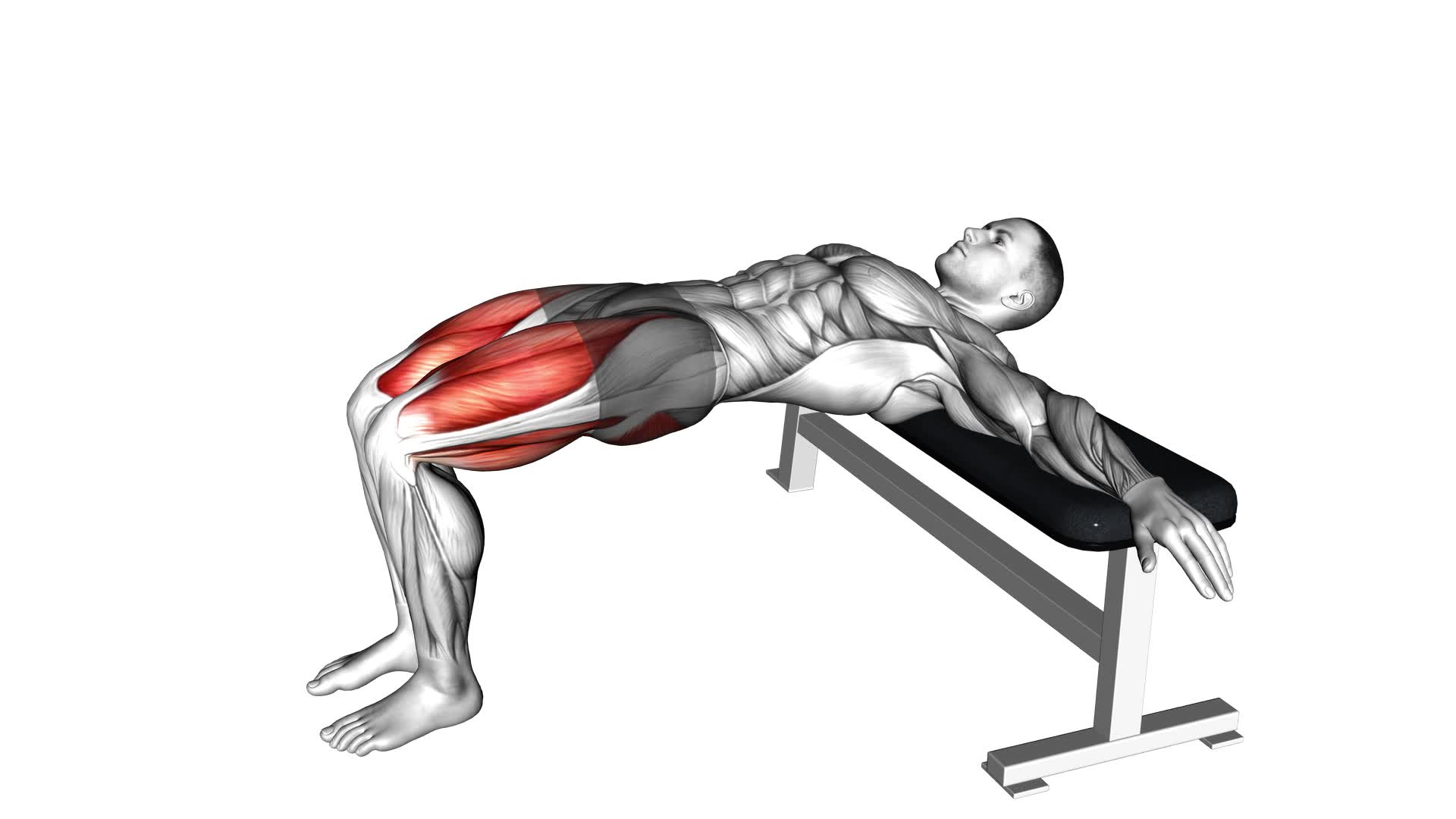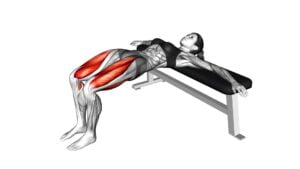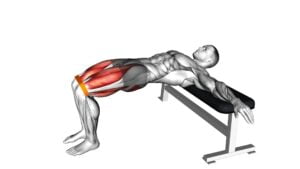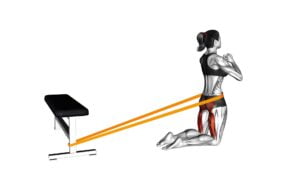Hip Thrusts – Video Exercise Guide & Tips

Looking to strengthen your glutes and improve your lower body strength? Hip thrusts are the perfect exercise for you! In this article, we will provide you with a video exercise guide and valuable tips to help you master hip thrusts.
Watch This Exercise Video
Learn about the benefits, the equipment you need, proper form, variations, common mistakes to avoid, and tips for progressing in this effective exercise.
Get ready to take your fitness to the next level with hip thrusts!
Key Takeaways
- Hip thrusts are beneficial for improving glute strength and lower body power.
- Proper form and starting with lighter weights are important for safety and effectiveness.
- Barbell, resistance bands, and hip thrust machine are essential equipment for hip thrusts.
- Alternative options such as bodyweight exercises and household items can be used if traditional equipment is unavailable.
Benefits of Hip Thrusts
To understand the benefits of hip thrusts, you should know that they can help improve your glute strength and enhance your overall lower body power. Hip thrusts are an effective exercise for glute activation, which is crucial for building strong, toned glutes. When you perform hip thrusts, you engage your glute muscles, specifically the gluteus maximus, to lift your hips off the ground. This movement targets your glutes directly, activating and strengthening them.
Hip thrusts are also great for muscle building. By incorporating heavy weights or resistance bands into your hip thrusts, you can increase the intensity of the exercise and stimulate muscle growth. The gluteus maximus is the largest muscle in the body, and by working it through hip thrusts, you can promote muscle hypertrophy and achieve a more sculpted, defined lower body.
In addition to glute activation and muscle building, hip thrusts also have functional benefits. Strong glutes are essential for everyday movements such as walking, running, and squatting. By strengthening your glutes through hip thrusts, you can improve your performance in sports and other physical activities.
Equipment Needed for Hip Thrusts
Now let's talk about the equipment you'll need for hip thrusts.
There are a few essential items you'll want to have on hand, such as a bench or stable surface to rest your upper back on, and a barbell or resistance band to provide resistance.
However, if you don't have access to these traditional pieces of equipment, don't worry – there are alternative options you can use.
Lastly, it's important to keep safety in mind when performing hip thrusts, so be sure to use proper form and start with lighter weights before progressing to heavier loads.
Essential Equipment for Hip Thrusts
You will frequently need essential equipment for hip thrusts.
While it's possible to do hip thrusts without equipment, using certain equipment can enhance your workout and target your glutes more effectively.
One of the best exercises for glutes, hip thrusts can be performed with a barbell, resistance bands, or a hip thrust machine.
Using a barbell allows you to progressively overload the glute muscles by adding weight.
Resistance bands provide constant tension throughout the movement, activating the glutes even more.
A hip thrust machine provides stability and support, making it easier to maintain proper form.
Whichever equipment you choose, make sure it's appropriate for your fitness level and allows you to perform hip thrusts safely and effectively.
Alternatives to Traditional Equipment
Consider using alternative equipment for hip thrusts to target your glutes effectively without relying on traditional equipment. Here are three options to try:
- Bodyweight exercises: You can perform hip thrusts using just your bodyweight. Lie on your back with your knees bent and feet flat on the ground. Lift your hips off the floor, squeezing your glutes at the top, and then lower back down. This is a great option if you don't have access to equipment or prefer a more challenging bodyweight workout.
- Resistance bands: Another alternative is to use resistance bands. Place the band just above your knees or around your thighs, and then perform the hip thrust as mentioned earlier. The resistance from the band will add an extra challenge to target your glutes even more.
- Furniture or household items: If you don't have access to traditional equipment or resistance bands, you can get creative and use furniture or household items. For example, you can use a sturdy chair or a stack of books as a platform to perform the hip thrusts.
Remember to maintain proper form and gradually increase the intensity as you get stronger.
Safety Precautions When Thrusting?
To ensure your safety and maximize the effectiveness of hip thrusts, it's important to use the proper equipment. When performing hip thrusts, it's crucial to have a stable and supportive surface to lean against. A bench or a sturdy exercise ball can provide the necessary stability. Additionally, using a hip thrust pad or a barbell pad can help protect your hips and provide a more comfortable experience.
It's also essential to maintain correct technique throughout the exercise to prevent common injuries. Make sure to engage your glutes and core muscles, and avoid overextending your lower back.
Proper Form for Hip Thrusts
To execute hip thrusts with proper form, ensure that you position your upper back against a stable surface, such as a bench, and rest your feet flat on the ground. This will provide you with a solid foundation to perform the exercise correctly and maximize its benefits.
Here are three key tips to help you maintain proper form during hip thrusts:
- Engage your core: Before lifting your hips, activate your core muscles by drawing your belly button in towards your spine. This will help stabilize your spine and prevent excessive arching.
- Squeeze your glutes: As you lift your hips, focus on squeezing your glutes at the top of the movement. This will ensure that you're primarily targeting your glute muscles and not putting unnecessary strain on your lower back.
- Maintain a neutral spine: Throughout the exercise, keep your spine in a neutral position, avoiding both excessive rounding and arching. This will help protect your back and ensure that the work is being done by your glutes.
Variations of Hip Thrusts
Try incorporating different variations of hip thrusts into your workout routine to target your glutes from different angles and challenge your muscles in new ways. If you're looking to take your hip thrusts to the next level, there are advanced variations that you can try. One option is the single-leg hip thrust, where you perform the exercise with only one leg on the ground, increasing the intensity and targeting one glute at a time.
Another advanced variation is the banded hip thrust, which involves using a resistance band around your knees or thighs to add extra resistance and activate your glutes even more.
Resistance band options can also be incorporated into your hip thrust variations. You can try the banded hip thrust with a looped resistance band around your hips, which adds resistance at the top of the movement where your glutes are fully engaged. Another option is the banded frog pump, where you place a resistance band just above your knees and perform the hip thrust with your feet together and knees apart, targeting the outer glutes.
Common Mistakes to Avoid During Hip Thrusts
To maximize the effectiveness of your hip thrusts and prevent potential injuries, it's crucial to be aware of and avoid common mistakes during this exercise. Here are three common mistakes to watch out for:
- Poor hip thrust technique: One of the most common mistakes isn't maintaining proper form during the exercise. Make sure to keep your feet shoulder-width apart, drive through your heels, and engage your glutes as you lift your hips off the ground. Avoid arching your back or relying on your lower back to lift the weight.
- Using too much weight: While it's important to challenge yourself, using excessive weight can lead to improper form and increase the risk of injury. Start with a weight that allows you to maintain proper technique throughout the movement.
- Neglecting hip thrust benefits: Hip thrusts are an excellent exercise for strengthening your glutes, improving hip stability, and enhancing overall lower body strength. However, many people neglect the full benefits of the exercise by not progressing in weight or adding variations to keep challenging their muscles.
By avoiding these common mistakes, you can ensure that you're performing hip thrusts correctly and reaping the maximum benefits.
Now, let's discuss some tips for progressing in hip thrusts.
Tips for Progressing in Hip Thrusts
To progress in hip thrusts, focus on gradually increasing the weight you use. This is one of the most effective ways to challenge your muscles and continue making progress. Start by adding small increments of weight, such as 5 or 10 pounds, and gradually increase as you become stronger. Incorporating progressive overload into your hip thrust routine will ensure that your muscles are constantly being challenged and stimulated for growth.
In addition to increasing weight, there are other progression tips and advanced techniques you can try. One popular method is performing single-leg hip thrusts. This variation adds an extra challenge by placing more emphasis on one side of the glutes at a time. You can also experiment with different tempos, such as slowing down the eccentric (lowering) phase of the movement or pausing at the top for a few seconds before lowering back down.
Implementing advanced techniques like band or chain resistance can also help take your hip thrusts to the next level. These tools provide additional resistance throughout the movement, making it more challenging for your muscles. Additionally, incorporating different variations such as elevated hip thrusts or using a stability ball can help target different areas of the glutes and provide a new stimulus for growth.
Frequently Asked Questions
How Many Sets and Reps Should I Do When Performing Hip Thrusts?
When performing hip thrusts, it's important to determine the appropriate sets and reps for your fitness level and goals.
Proper form tips, variations, and progressions can help you get the most out of this exercise.
Depending on your program, you may start with 2-3 sets of 10-12 reps and gradually increase the intensity over time.
Remember to incorporate hip thrusts into a full body workout routine for optimal results.
Can Hip Thrusts Help Improve My Squat and Deadlift Strength?
Incorporating hip thrusts into your strength training program can indeed help improve your squat and deadlift strength. Hip thrusts target and strengthen the glutes, which play a crucial role in both movements.
Are Hip Thrusts Suitable for Beginners or Should I Have a Certain Fitness Level Before Attempting Them?
Hip thrusts can be a beneficial exercise for beginners, but it's important to start with proper form and technique. If you're new to fitness, consider starting with alternatives or modifications that allow you to build strength gradually.
As you progress and feel more comfortable, you can gradually increase the intensity of your hip thrusts. It's always a good idea to consult with a fitness professional or trainer to ensure you're performing exercises safely and effectively.
Can Hip Thrusts Be Done Without Any Equipment or With Alternative Equipment?
You may be wondering if hip thrusts can be done without any equipment or with alternative equipment.
The good news is that yes, you can do hip thrusts without any equipment by simply using your body weight. This exercise is great because it targets your glutes and hamstrings, helping to build strength and improve your overall lower body stability.
Are There Any Specific Warm-Up Exercises or Stretches That Should Be Done Before Performing Hip Thrusts?
Before performing hip thrusts, it's important to do some warm-up exercises and stretches. This will help prepare your muscles and reduce the risk of injury. Some good warm-up exercises include glute bridges and bodyweight squats.
As for stretches, focus on the hip flexors and hamstrings.
Hip thrusts have many benefits, like strengthening the glutes and improving lower body stability. However, common mistakes include using too much weight and not maintaining proper form.
Conclusion
In conclusion, hip thrusts are an effective exercise for targeting and strengthening the glutes and hip muscles. By using the proper form and gradually progressing in difficulty, you can maximize the benefits of this exercise.
Remember to avoid common mistakes and use variations to keep challenging your muscles. With the right equipment and technique, hip thrusts can help you achieve a stronger and more toned lower body.

Author
Years ago, the spark of my life’s passion ignited in my mind the moment I stepped into the local gym for the first time. The inaugural bead of perspiration, the initial endeavor, the very first surge of endorphins, and a sense of pride that washed over me post-workout marked the beginning of my deep-seated interest in strength sports, fitness, and sports nutrition. This very curiosity blossomed rapidly into a profound fascination, propelling me to earn a Master’s degree in Physical Education from the Academy of Physical Education in Krakow, followed by a Sports Manager diploma from the Jagiellonian University. My journey of growth led me to gain more specialized qualifications, such as being a certified personal trainer with a focus on sports dietetics, a lifeguard, and an instructor for wellness and corrective gymnastics. Theoretical knowledge paired seamlessly with practical experience, reinforcing my belief that the transformation of individuals under my guidance was also a reflection of my personal growth. This belief holds true even today. Each day, I strive to push the boundaries and explore new realms. These realms gently elevate me to greater heights. The unique combination of passion for my field and the continuous quest for growth fuels my drive to break new ground.







